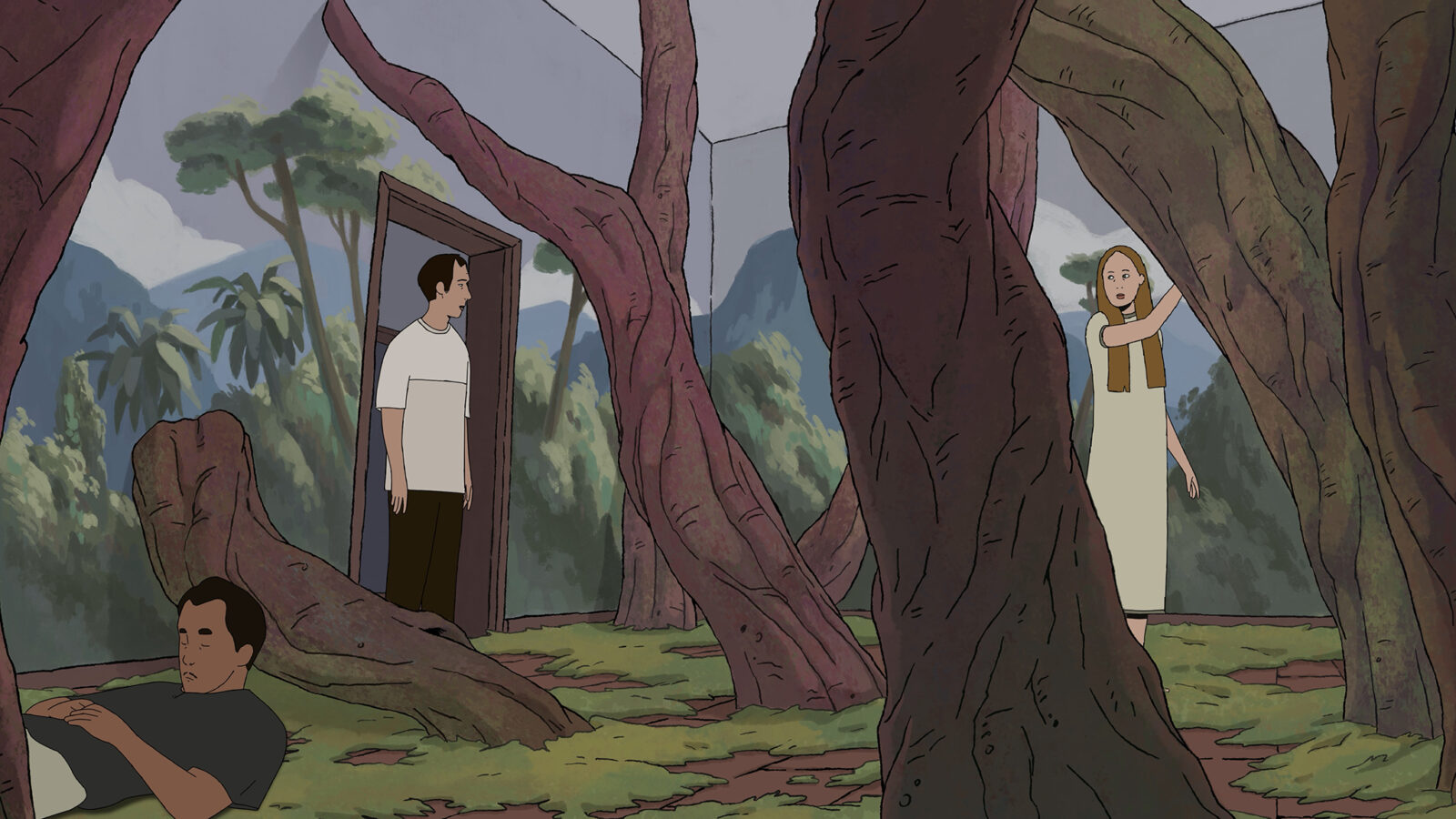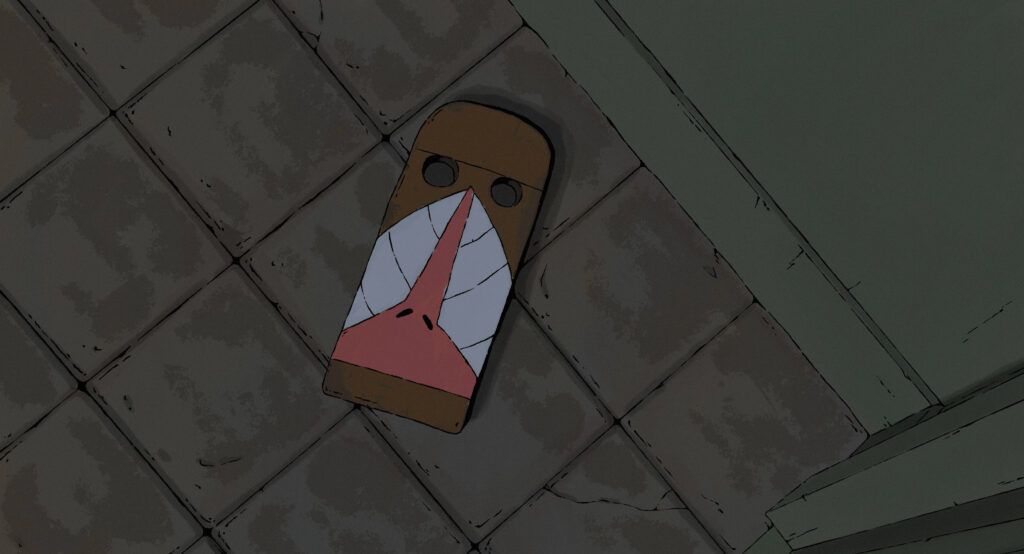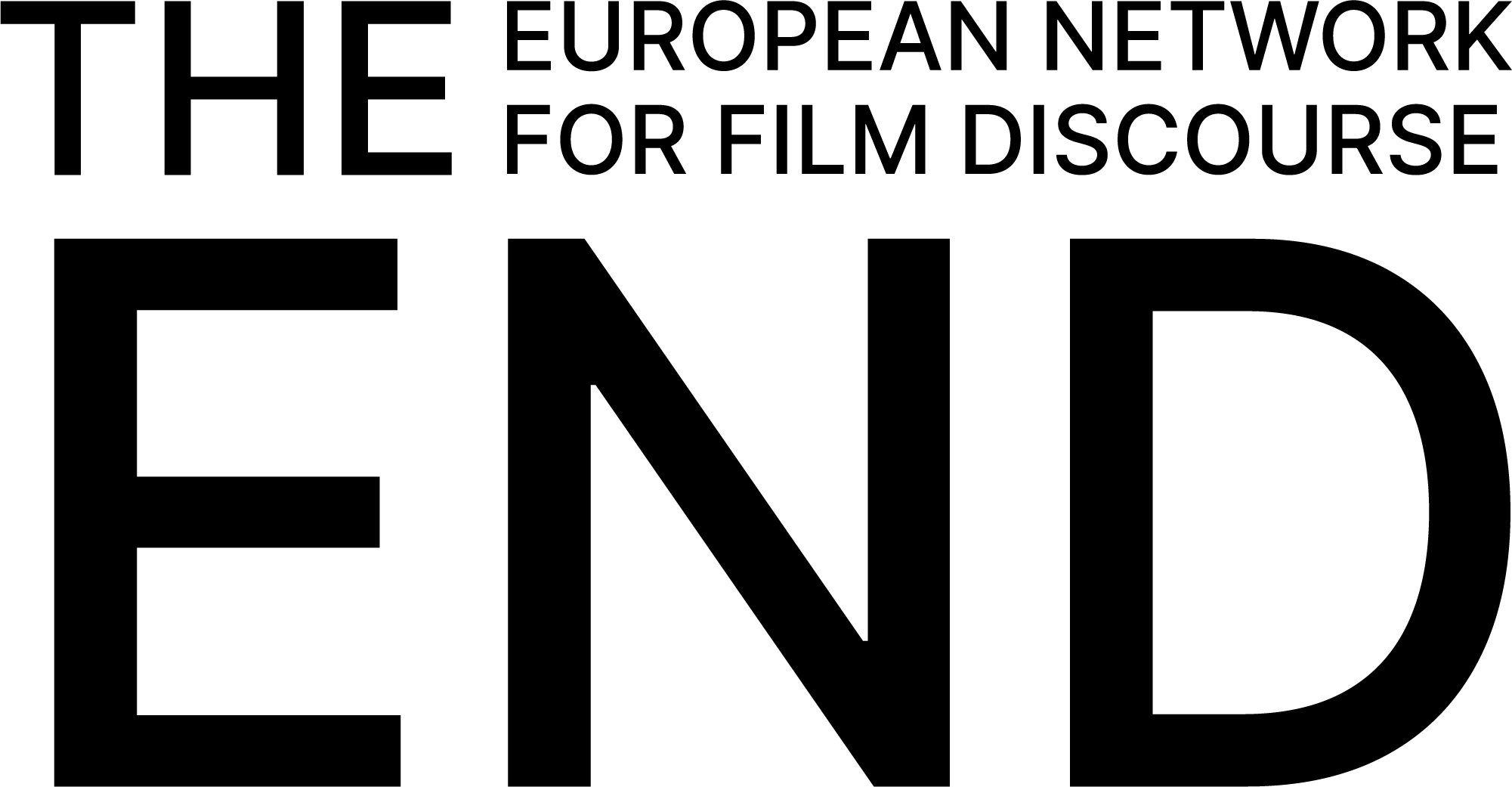Banana for Brains
Interview with Alexandre Sousa
Probing the boundaries of animated storytelling, Alexandre Sousa’s debut deeply yearns for human connection through surrealist imagery.

On a sunny morning in Vila do Conde, the small seaside town where the 33rd edition of Curtas Vila do Conde is underway, I meet with Alexandre Sousa in a park with a view of the Atlantic Ocean and a seaside monastery. The young writer-director is attending Curtas with Amarelo Banana (2025), his first short, and he smiles broadly as we make some small talk while looking for an empty bench in the shade.
At first glance, Amarelo Banana unfurls like another commentary on the need to escape our everyday ennui and persistent sense of unfulfillment. The animated short’s desaturated palette, tinged with a subtle grey, breathes life—or rather, lifelessness—into its protagonist: a man in his late twenties with no particularly defining features, aside from some ever-present dark circles under his eyes. A universal everyman, he seeks relief from reality in wildlife documentaries. But the TV works as a catalyst, stoking the man’s wish to shed his consciousness onto the pixelated screen, while also anticipating the getaway he’ll enjoy in a safari that will magically play out on the floor above his apartment.
Yet Amarelo Banana isn’t simply about escapism, Sousa says, but “about the very meaning of human connection.” Despite the surreal flourishes, the film is rooted in a familiar emotional state, one that was nonetheless inspired by an absurd moment in the director’s life. “[Amarelo] is based on a true story, which surprises people,” he laughs. “I was at this really strange party, feeling socially anxious. Then someone dressed as a monkey jumped on stage. He was so energetic, so engaging that everyone started dancing within seconds. And then out of nowhere, he pulls a banana, takes a bite, and passes it to the first person in the crowd. That person takes a bite, passes it on, and so on, until it gets to me. Suddenly, I have three hundred people watching, waiting for me to be part of this cult moment. It was bizarre and funny, but later I realised there was a story rooted in that awkward moment.”
Asked if he relates to his protagonist, Sousa says that his mental state at the time reflected that of his unnamed drifter. However, he admits that he lacks the young man’s inquisitiveness and courage, and that he struggled to find a good narrative hook to make him leave the comfort of his apartment and explore the world upstairs. Sousa also cites Being John Malkovich (1999) as one of his many influences—specifically, a scene that made its way into Amarelo Banana, where John Cusack’s character speaks with a monkey about the “terrible curse” of having a consciousness.
As a group of ape-behaving people confront him with the black-or-white choice to keep or lose his consciousness—which is to say, what makes him human—the protagonist opens his flat’s window to call for help. He glances for a second at the outside world, which Sousa keeps off-screen, then shuts the window. For the director, the decision symbolises the ultimate loss of hope. Drawing from sirens, distant shouts, and an omnipresent feeling of violence, the film’s soundscape (developed by composer André Aires) evokes a chaotic outside world. Yet none of it is ever shown. “We wanted the outside to remain subjective,” he explains. “So everyone can decide what the problem is, whether it’s war, or something much more personal.”
Much like other primates, humans crave connection, recognition, and inclusion. But the unwritten rules of society often make that connection difficult to achieve. Many of us find ourselves surrounded by people, yet unable to form lasting bonds. These inner feelings are reflected by an outer world full of conflict and uncertainty, with no manual for how to navigate it. “The whole point of the film,” Sousa says, “is whether you prefer the real world hitting you in the face, or the easier route, pretending nothing is happening. Everyone does this, at one level or another, whether it’s the biggest problems or the smallest. That call for help is not just from the protagonist. Every character in the film has had that moment; every single one of them was the main character at some point.”
With no lines of dialogue, the short relies on non-verbal communication, shifting from sign language before the protagonist gains entry into the urban makeshift safari to onomatopoeia once he is granted access. The only moment in which the man tries to speak, he is shushed by a receptionist who points to a sign that warns no talking is allowed. Language must be forgotten in order to belong. And forgetfulness is what Sousa’s protagonist chooses. Despite this seemingly simple approach to storytelling, the sound design is so carefully crafted that it manages to create a strong sense of uneasiness and tension throughout the short. The soundtrack is composed of chants that grow louder, signaling the looming conflict between the human protagonist and the tribe. Alongside the gestures that give way to meaningless mimicry, any remaining traces of humanity are replaced by the chatter of apes and vacant stares.

© Amarelo Banana (Alexandre Sousa, 2025)
Amarelo Banana screened in the International Competition at Curtas, preceded by Jocelyn Charles’s God is Shy (2025), a French short that plunges one into the depths of the subconscious, where the border between dreams and reality becomes porous. “Funnily enough,” Sousa said when I asked him about his influences, Charles’s short “was the main inspiration for my character’s design in Amarelo Banana. Nicholas Keppens, who made Easter Eggs [2020] and Beautiful Men [2023], is an incredible inspiration for me as well.” Across Portugal, Sousa admires young animator João Gonzales, who, in his opinion, “influences a lot of Portuguese filmmakers”, and also cites the revolutionary Akira (1988) as one of his favorite animation films of all time. All of these touchstones can be easily traced back to Sousa’s style, which welds a surrealist approach to a very humane and at times humorous register.
Before Amarelo Banana, Sousa animated a handful of commercials, including an awareness campaign for WHO, and also worked on Vicente Nirō’s short T-Zero (2024). However, there is a striking stylistic contrast between that film’s minimal line art and rich colour compositions and Sousa’s own, in which clear black lines define each object, with the colours taking on a seemingly lifeless quality. For a film centered on a man fed up with his life and world around him, the bleak aesthetic heightens all the nihilism he experiences over the course of that night.
Despite having previous experience in film animation, Amarelo Banana marks the filmmaker’s debut on the festival circuit. Following its world premiere at the International Film Festival Rotterdam and later stops at Annecy, Hong Kong International Film Festival, and Vienna Shorts, the film has since attracted attention from fellow Portuguese directors for its stylistic peculiarities and stark departures from other approaches to animation in the country, which Sousa sees as “more plastic, more traditional and more grounded”.
Now, the filmmaker is working on his second short, Prado. A far cry from his debut, in which interiors mimicked the outside world, Prado will deal with vast and desolate vistas that reflect the internal feelings of the two main characters, brothers whose paths are on the verge of forking into opposite directions. “Amarelo Banana started from a true story and then expanded into a concept,” Sousa explains. “Prado is the opposite. It’s deeply personal. It’s about the place I grew up in, a town where people feel like their lives don’t matter. That kind of environment creates social problems that I want to explore.” Sousa puts an almost Don Quixotean twist to one of his main characters, a man who has had enough of the small town and “relates a lot to this one wind turbine [by the village] that never spins because there’s no wind in the town.”
The surrealist quality of Sousa’s work resides not only in his storytelling—so prone to absurdist, dreamlike twists—but also in the director’s interest in emphasising the subjectivity of his characters’ emotions; animation grants us a chance to “stretch individual perspectives and distort them in a way that exaggerates one’s feelings.” Kicking off his career with a provocative and thoughtful short, Sousa appears committed to probing the boundaries of animated storytelling through personal mythology and a deep yearning for human connection.
Sousa’s filmmaking challenges the viewer to not only question what is real but to confront how we cope with disillusionment, isolation, and identity in a chaotic world. Through Amarelo Banana, he proves that animation can be a profound vessel for existential inquiry.
This text was developed during the European Workshop for Film Criticism #7—a tandem workshop set during Curtas Vila do Conde and FeKK – Ljubljana Short Film Festival—and edited by workshop tutor Leonardo Goi.
The European Workshop for Film Criticism is a collaboration of the European Network for Film Discourse (The END) and Talking Shorts, with the support of the Creative Europe MEDIA programme.




